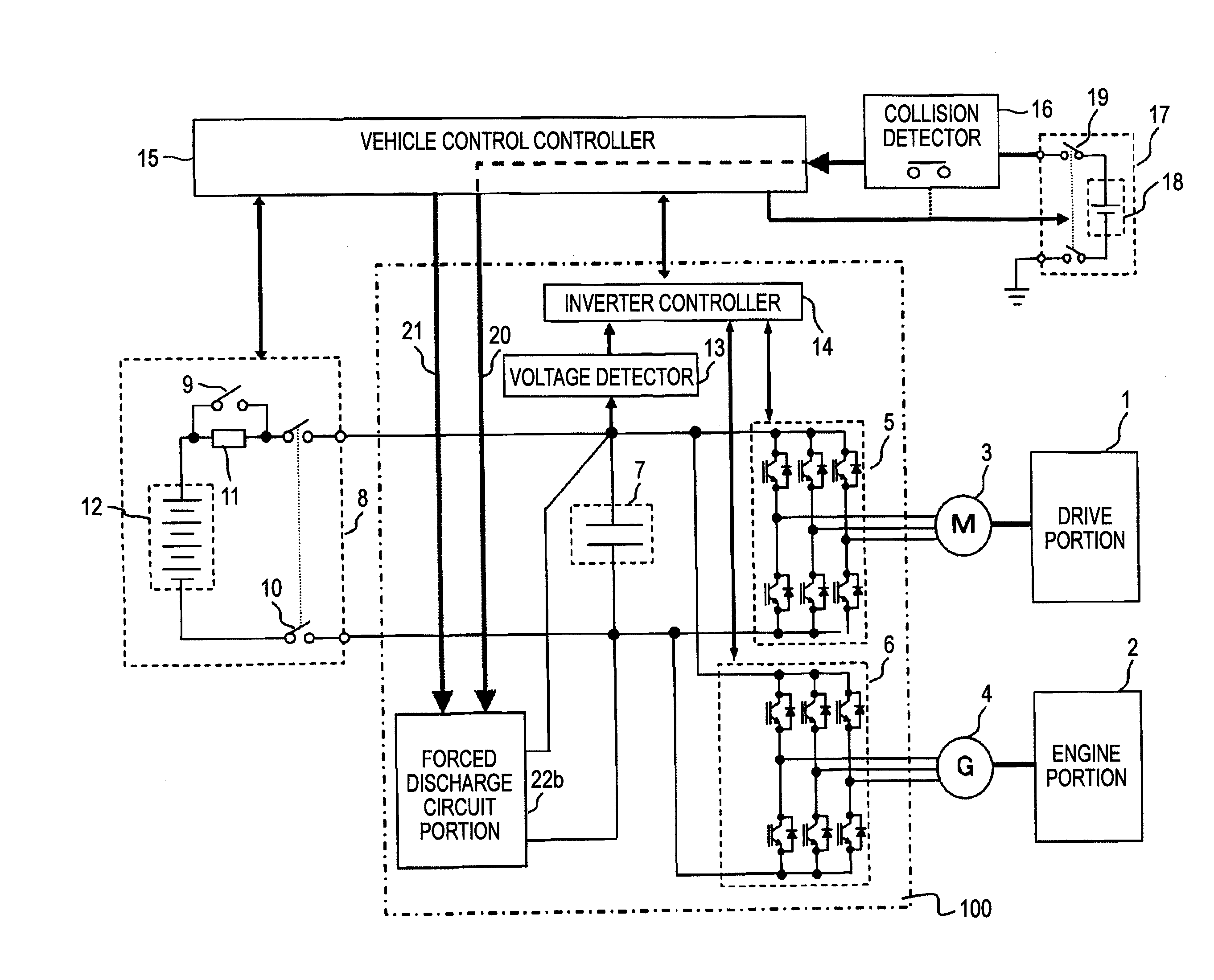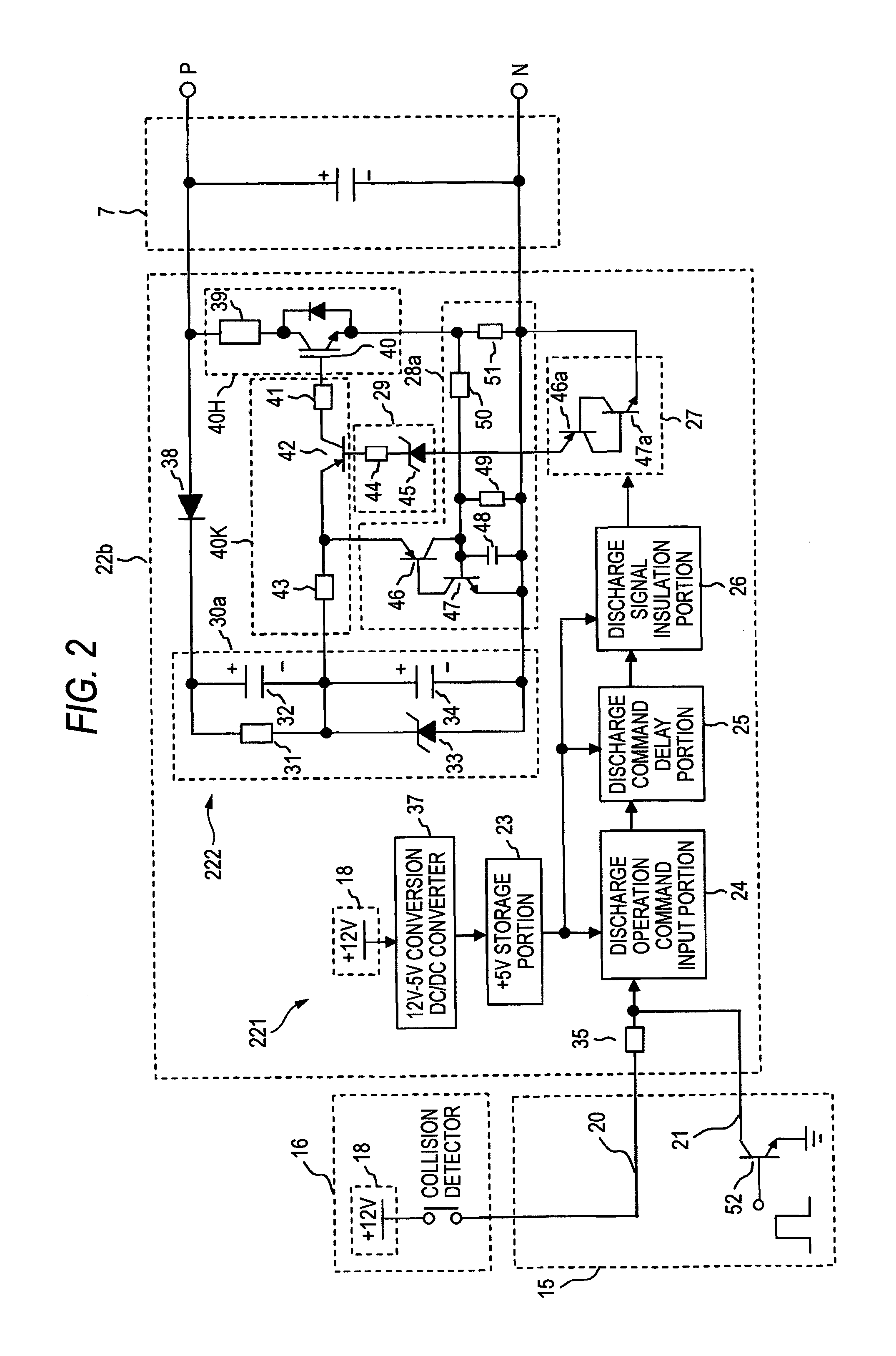Electric vehicle inverter apparatus and protection method therefor
a protection circuit and inverter technology, applied in the direction of battery/fuel cell control arrangement, testing/monitoring control system, instruments, etc., can solve the problems of discharge resistor burnout, increase in manufacturing cost, discharge resistor burnout, etc., to achieve the effect of enhancing design flexibility, reducing manufacturing cost and reducing manufacturing cos
- Summary
- Abstract
- Description
- Claims
- Application Information
AI Technical Summary
Benefits of technology
Problems solved by technology
Method used
Image
Examples
embodiment 1
[0168]FIG. 1 illustrates the entire configuration of an electric vehicle inverter apparatus according to Embodiment 1 of the invention and peripheral devices thereof.
[0169]Referring to FIG. 1, reference numeral 1 designates a vehicle drive portion such as tires and wheels. Numeral 2 denotes an electric vehicle power-generating engine portion. Numeral 3 designates a three-phase AC electric motor mechanically connected to the vehicle drive portion 1. Numeral 4 denotes a three-phase AC electric generator for generating electric power by the drive force of an engine. Numeral 100 designates an inverter apparatus. Numeral 8 denotes a car-mounted high-voltage battery unit. Numeral 15 designates a vehicle control controller for supervisingly controlling the entire vehicle. Numeral 16 denotes a collision detector which operates, when detecting impact caused by a collision between electric vehicles, so that an internal switch is opened. Numeral 17 designates a low-voltage battery unit.
100>>
[0...
embodiment 2
Circuit Configuration of Embodiment 2
[0182]FIG. 2 is a diagram illustrating the details of the forced discharge circuit portion 22b illustrated in FIG. 1 according to Embodiment 2 of the invention. As illustrated in FIG. 2, a circuit according to Embodiment 2 includes the collision detector 16, the vehicle control controller 15, the forced discharge circuit portion 22b, and the main circuit capacitor 7 of the inverter apparatus 100. The collision detector 16 connected in the “open” state to the low-voltage battery unit 17 (see FIG. 1) outputs a discharge signal (FD1) 20 to the forced discharge circuit portion 22b as a collision detection signal via the vehicle control controller 15.
[0183]In addition, the vehicle control controller 15 connects the collector of a grounded-emitter transistor 52 to the discharge signal (FD1) 20. The vehicle control controller 15 outputs the discharge signal (FD2) 21 to the forced discharge circuit portion 22b in response to a turn-on operation of the gr...
embodiment 3
Difference Between Forced Discharge Circuit Portion According to Embodiment 3 and that According to Embodiment 2
[0212]FIG. 8 is a diagram illustrating the details of a forced discharge circuit portion 22c according to Embodiment 3 of the invention.
[0213]The differences between the forced discharge circuit portion 22b illustrated in FIG. 2 and the forced discharge circuit portion 22c according to Embodiment 2 are as follows. 1) As illustrated in FIG. 8, the discharge command latch portion 55 is added. A discharge state signal (FD3) 54 output from the discharge command latch portion 55 is connected to the base of the grounded-emitter transistor 53 for monitoring the discharge state of the vehicle control controller 15. 2) The discharge signal latch circuit portion 27 illustrated in FIG. 2 is replaced with the PNP transistor 46b. The resistor 35 and the NPN transistor 52 illustrated in FIG. 2 are eliminated.
[0214]Hereinafter, the functional block portion relating to the aforementioned ...
PUM
 Login to View More
Login to View More Abstract
Description
Claims
Application Information
 Login to View More
Login to View More - R&D
- Intellectual Property
- Life Sciences
- Materials
- Tech Scout
- Unparalleled Data Quality
- Higher Quality Content
- 60% Fewer Hallucinations
Browse by: Latest US Patents, China's latest patents, Technical Efficacy Thesaurus, Application Domain, Technology Topic, Popular Technical Reports.
© 2025 PatSnap. All rights reserved.Legal|Privacy policy|Modern Slavery Act Transparency Statement|Sitemap|About US| Contact US: help@patsnap.com



